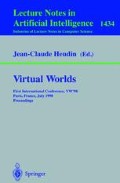Abstract
We suggest in this article a new paradigm for the representation of data, which is best suited for the real-time visualization and sonorisation of complex systems, real or simulated. The basic idea lies in the use of the garden metaphor to represent the dynamic evolution of interacting and organizing entities. In this proposal, multiagent systems are used to map between given complex systems and their garden-like representation, which we call Data Gardens (DG). Once a satisfying mapping has been chosen, the evolution of these Data Gardens is then driven by the real-time arrival of data from the system to represent and by the endogenous reaction of the multiagent system, immersing the user within a visual and sonorous atmosphere from which he can gain an intuitive understanding of the system, without even focusing his attention on it. This can be applied to give life to virtual worlds by grounding them in reality using real world data.
Access this chapter
Tax calculation will be finalised at checkout
Purchases are for personal use only
Preview
Unable to display preview. Download preview PDF.
References
Boden M. A., “Agents and Creativity”, in Communications of the ACM, Vol. 37, No. 7, pp. 117–121, July 1994
Bruning J. L. and Kintz B. L., Computational handbook of statistics, Glenview, IL: Scott, Foresman and Company, 1968.
Bonabeau G. and Theraulaz E. eds., L’intelligence Collective, Hermès, Paris, 1996.
Coutaz J., “L’art de communiquer à plusieurs voies”, Spécial La Recherche “L’ordinateur au doigt et à l’oeil”, no285, mars 1996, pp. 66–73.
Deneubourg J.-L. and Theraulaz G., Beckers R., “Swarm-Made Architectures”, in Towards a Practice of Autonomous Systems, MIT Press, Cambridge, pp. 123–133, 1992.
Domik G., “The Role of Visualization in Understanding Data”, Lecture Notes on Computer Science 555, “New Trends and Results in Computer Science”, pp. 91–107, Springer Verlag, 1991.
Drogoul A., “De la simulation multi-agents à la résolution collective de problèmes”, Thèse de l’Université Paris VI, Novembre 1993.
Ferber J., Les systèmes Multi-agents, Interéditions, Paris, 1995.
Gebhardt N., “The Alchemy of Ambience”, Proceedings of the 5th International Symposium on Electronic Art, Helsinki, 1994.
Gelernter D., Mirror Worlds, Oxford University Press, Oxford, 1992.
Hutzler G., Gortais B., Drogoul A., “The Garden of Chances: an Integrated Approach to Abstract Art and Reactive DAI”, 4th European Conference en Artificial Life, Husbands P. and Harvey I. eds., pp. 566–573, MIT Press, 1997.
Ishii H. and Ullmer B., “Tangible Bits: Towards Seamless Interfaces between People, Bits and Atoms”, Proceedings of CHI’ 97, ACM, Atlanta, 1997.
Ishizaki S., “Multiagent Model of Dynamic Design-Visualization as an Emergent Behavior of Active Design Agents”, Proceedings of Conference on Human Factors in Computing Systems (CHI’ 96), ACM, Vancouver, 1997.
Kandinsky W., Du spirituel dans l’art et dans la peinture en particulier, Gallimard, Paris, 1989.
Kandinsky W., Point et ligne sur plan-Contribution à l’analyse des éléments de la peinture, Gallimard, Paris, 1991.
Klee P., Théorie de l’art moderne, Denoël, Paris, 1985.
Larkin J. H. et Simon H. A., “Why a Diagram is (Sometimes) Worth Ten Thousands Words”, Cognitive Science, 11, pp. 65–69, 1987.
Penny S., “The Darwin Machine: Artificial Life and Art”, Proceedings of the 5th International Symposium on Electronic Art, Helsinki, 1994.
Rao R., “Quand l’information parle à nos yeux”, Spécial La Recherche “L’ordinateur au doigt et à l’oeil”, no285, mars 1996, pp. 66–73.
Resnick M., “Overcoming the Centralized Mindset: Towards an Understanding of Emergent Phenomena”, in Constructionism, Harel I. and Papert S. eds., pp. 205–214, Ablex, Norwood, 1991.
Risan L. ““Why are there so few biologists here?”-Artificial Life as a theoretical biology of artistry”, Proceedings of the Fourth European Conference on Artificial Life, Husbands P. and Harvey I. eds., pp. 28–35, MIT Press, 1997.
Tufte E. R., The Visual Display of Quantitative Information, Graphics Press, Cheshire CN, 1983.
Wagensberg J., L’âme de la méduse, Seuil, Paris, 1985.
Wright R., “Art and Science in Chaos: Contesting Readings of Scientific Visualization”, Proceedings of the 5th International Symposium on Electronic Art, Helsinki, 1994.
Author information
Authors and Affiliations
Editor information
Editors and Affiliations
Rights and permissions
Copyright information
© 1998 Springer-Verlag Berlin Heidelberg
About this paper
Cite this paper
Hutzler, G., Gortais, B., Drogoul, A. (1998). Grounding Virtual Worlds in Reality. In: Heudin, JC. (eds) Virtual Worlds. VW 1998. Lecture Notes in Computer Science(), vol 1434. Springer, Berlin, Heidelberg. https://doi.org/10.1007/3-540-68686-X_26
Download citation
DOI: https://doi.org/10.1007/3-540-68686-X_26
Published:
Publisher Name: Springer, Berlin, Heidelberg
Print ISBN: 978-3-540-64780-5
Online ISBN: 978-3-540-68686-6
eBook Packages: Springer Book Archive

